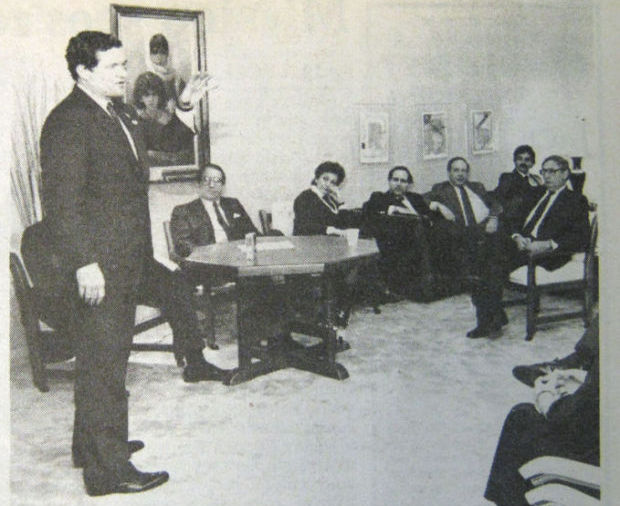Haunting parallels: Iraq in 1991 and Syria in 2013
Published September 4, 2013
Many Americans are deeply concerned over the rapidly unfolding events in Syria since its savage atrocity of using a deadly chemical weapon against Bashar Assad’s own people in the suburbs of Damascus and the near certainty of an American-led military response. The American Jewish community is specifically concerned about the possibility that Israel may be dragged into a regional conflict.
The current situation unfolding in Syria brings to mind a horrific situation of decades earlier, namely January 1991, when another brutal Middle East dictator, Saddam Hussein of Iraq, brazenly invaded and occupied Iraq’s tiny neighbor Kuwait. Then President George H. W. Bush declared “this shall not stand” and proceeded to organize a large coalition of nations to launch Operation Desert Storm. The goal was to drive out Saddam Hussein’s forces and liberate Kuwait, a mission that achieved success with almost lightening speed in a conflict that lasted just over 100 hours.
The 1991 Persian Gulf conflict, while different in origin and scope from the more limited action envisioned against Syria, contains some haunting parallels to the current crisis. Hussein, like Assad, was a vicious dictator, who had himself used chemical weapons in the Iran-Iraq War and later against his own Kurdish citizens who were seeking greater autonomy. In 1991, Saddam launched 39 deadly SCUD missiles against targets in Israel, where citizens had bought gas masks and built makeshift shelters in case chemical weapons were used — fortunately, he did not, but once a tyrant has used such weapons, there is no guarantee he will not use them again.
The Light, in January 1991, gave extensive coverage to the Iraqi conflict and the local Jewish community response. As editor then, I wrote in a story in the Jan. 22 edition about the “emotional rollercoaster on which the Jewish community has been riding since the outbreak of the war in the Persian Gulf” on Jan. 16.
The piece continued, “For the Jewish community the days leading up to and following Jan. 16 have been alternately shocking, hopeful, disturbing and profoundly sad.” I described as “most dramatic,” the moment Sen. Christopher S. (Kit) Bond, R-Mo., addressed the JCRC Israel Task Force on Wednesday, Jan. 16.
Like everyone else in the crowded conference room, Bond was physically exhausted but emotionally alert over the possibility that war might break out at any minute, since the Jan. 15 deadline set by the U.S. and its allies for an Iraqi withdrawal from Kuwait had expired at midnight. Bond was about to conclude his briefing of the task force when his legislative counsel was called to the telephone to take a call from Bond’s Washington office. Bond was passed a Post-It note, which he read out, ‘According to the networks, Baghdad is under attack.’” The time was 5:43 p.m.
The people in the room—all of them highly educated and intellectually focused individuals — collectively gasped. Rabbi Jeffrey Bienenfeld of Young Israel offered a prayer.
A TV was quickly brought into the conference room and turned on. Marlin Fitzwater, President Bush’s press secretary, intoned, with solemnity in his voice, “The Liberation of Kuwait has begun.”
The previous week, the Light had come up with a headline for its Jan 16, 1991 edition, ISRAEL READY TO RESPOND, with a photograph of an Israeli fighter pilot in the cockpit of his plane. The caption pointed out the high state of military alert in Israel in the event that Hussein made good on his threat to attack Israel. By Thursday morning, after the paper arrived in readers’ homes, the headline was already out of date with the reports that two Iraqi SCUD missiles aimed at Israel had been knocked out. Some 37 other SCUDS would land on Israel, including Tel Aviv, and cause extensive damage and a relatively small number of deaths and injuries. Thankfully, no chemical weapons were used.
The Israeli government was under intense pressure to directly retaliate against Iraq, but was talked out of doing so by the Bush Administration. Bush quickly deployed a battery of U.S.-made Patriot missiles, which have a track record of intercepting and destroying incoming missiles like SCUDS. Since those days, Israel and the U.S. jointly designed the Arrow missile and Iron Dome defenses, which are now in place.
Many of the same elements that were in play back then are present in the current crisis involving Syria. Let us hope that whatever punishment is meted out to Assad for his use of chemical weapons against civilian men, women and children will send the right message and not make an already horrific situation even more unstable.
















